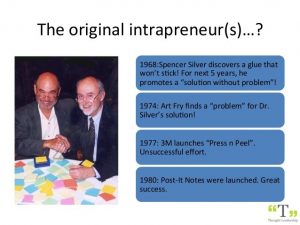Intrapreneurs wanted
Today many large business houses in the world depend on product innovations, functional innovations, cost innovations, marketing innovation, and supply chain innovations – innovations in all areas to cut costs and easily expand globally. Mergers and acquisitions only turn out well if organizations can maintain innovations with what they have bought. To remain relevant in a rapidly changing world companies need a high volume of cost effective innovation. Just as entrepreneurs grow their organizations by innovating, intrapreneurs play a vital role in organizations for supporting growth of business.
Gifford Pinchot III in 1984 defined intrapreneurs as “dreamers” in organizations who do things differently. They are creative and enthusiastic in nature. In 1992, The American Heritage Dictionary acknowledged the popular use of a new word, intrapreneur, to mean “A person within a large corporation who takes direct responsibility for turning an idea into a profitable finished product through confident risk-taking and innovation” Koch (2014) goes further, claiming that intrapreneurs are the “secret weapon” of the business world. Based on these definitions, being an intrapreneur is considered to be beneficial for both intrapreneurs and large organizations. Companies support intrapreneurs with finance and access to corporate resources, while intrapreneurs create innovation for companies.
An intrapreneur acts as an entrepreneur within the boundaries of a large firm, who uses entrepreneurial skills without incurring the risks associated with those activities. Entrepreneurs take risks at their own cost, whereas intrapreneurs take risks at company’s cost. Intrapreneurs are usually employees within a company who are assigned to work on specific projects, and they are instructed to develop the project like an entrepreneur would do. Intrapreneurs usually have the resources and capabilities of the firm at their disposal. Having innovative and talented leadership is need of the hour in big organizations. Researchers have constantly found that at the root of every successful corporate innovation, there are one or more passionate intrapreneurs. Intrapreneurs have the perseverance, courage and shrewdness to get to turn opportunities into profitable realities.
Mr. S. Sivakumar who is today the Divisional Chief Executive of ITC Agri Business Division is credited for the e-Choupal initiative. The e-Choupal was developed and executed under Sivakumar’s leadership of the Agri Business Division. Sivakumar worked with a farmers’ cooperative for six years before joining ITC in 1989. ITC’s e-Choupal links directly with rural farmers via the Internet for procurement of agricultural and aquaculture products like soybeans, wheat, coffee, and prawns. Thus making life of farmers much easier without middlemen in the supply.
Organizations encourage innovations among their people because they understand that there is no great deal in blocking new ideas and suggestion from people. Intrapreneurship flourishes on the foundation of relationships and not on processes. The relationship quality between an intrapreneurial team and the management of the organization is important. When organizations understand the value the efforts of intrapreneurs to strengthen the value of products and services, the outcomes are constructive. The management is expected to help the intrapreneurs to find resources and guide them around political dangers. They must defend them by fostering talent and friendlier policies.
Sometimes, intrapreneurship happens by accident. Dr. Spencer Silver, a scientist at 3M, was attempting to create an extremely strong adhesive to use in aerospace technology. Instead, he accidentally created a light adhesive that stuck to surfaces well but didn’t leave a nasty residue.
Instead of hurling away this idea because it didn’t solve the problem at hand, he stuck with it until he found a use for it. After many years of persistence and spreading the word it finally clicked with someone else, Art Fry, another 3M scientist. He attended one of the seminars of Dr.Silvers, he also sung in a church choir in St. Paul, Minnesota. One little problem he continually had to deal with was accidentally losing his song page markers in his hymn book while singing, with them falling out of the hymnal. From this, he eventually had the stroke of genius to use some of Silver’s adhesive to help keep the slips of paper in the hymnal. Fry then suggested to Silver that they were using the adhesive backwards. Instead of sticking the adhesive to the bulletin board, they should “put it on a piece of paper and then we can stick it to anything. And, they began to develop a product together. Post-It notes were born and today you find them in all offices in the world.
It requires a great amount of imagination and understanding the value of a really new idea, and more importantly it requires a great process. Ideas look different on papers, and different when executed. Another fact is that many ideas remain on the paper, because to execute them it takes courage. An effective intrapreneureal program is a cultural shift. It involves educating both intrapreneurs and potential sponsors on their roles and effective behavior. Because these roles involve trust, not everyone can find a sponsor. Also, a company generates more good ideas in a month than it can implement in a decade. Only few ideas are shaped.
Can you imagine that a guard at Massachusetts Department of Correction suggested a change in the way the department stored their inmate photos. Instead of taking pictures with film and storing them the old fashioned way, the guard suggested to use digital cameras to create a database for image storing. The department has sixteen correctional facilities and in the first year of implementation alone it saved $56,000 dollars on film and eased a lot of clerical headache.
Potential intrapreneurs exist in every organization; in most they don’t come out in open because of politics brewing in the culture. The terms entrepreneurs and intrapreneurs are used interchangeably because they both contain the same meaning. However, the fact is that there exists a fine line between these two terms. As business leaders strive for increased competitiveness, creating an entrepreneurial culture has become an important facet in business world. In the current business environment, the term entrepreneurial has come to mean more than just the business acumen required to turn an idea into an enterprise.
In Kinetic India, one of their recent models, the Zing, was an idea that came from one of their employees. He suggested that the mobike must have a mobile charger built in it. The idea was innovative and was highly appreciated. The research and development (R&D) team researched and implemented the idea.
When intrapreneurs believe in change and do not fear failure, they discover new ideas and look for such opportunities that can benefit the whole organization. The job of an intrapreneur is extremely challenging; hence they are appreciated and rewarded by the organisation accordingly. From past decade, innovation and creativity has become a trend that large corporations look out for intrapreneurs, to bring operational excellence and gain competitive advantage. A big part of driving an entrepreneurial culture is to foster innovations.
Organizations must empower people. People must feel empowered to take the lead and create positive change. Culture is a shared phenomenon, and although leaders play a key role in shaping it, they set examples by their behavior.
Creative and effective organizations do not emerge by accident. They require leaders to drive and control deliberate changes in structure, culture, and processes in order to transform them into creative, effective, and productive ones. Even though many organizations look for competitive advantage in their structure, strategy, technology, and culture, leadership is the most important source of competitive advantage. Organizational leaders usually decide what happens in the organization and give the direction, vision, and momentum that bring success. Therefore, leaders are the catalyst that create and manage the entrepreneurial culture.
















































